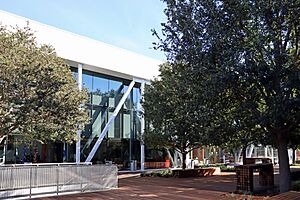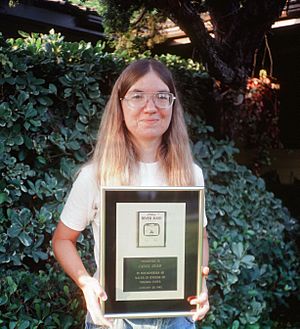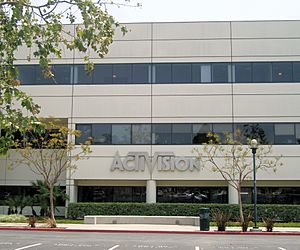Activision facts for kids
 |
|

Current headquarters in Santa Monica in 2025 (shared with Activision Blizzard)
|
|
|
Formerly
|
|
|---|---|
| Subsidiary | |
| Industry | Video games |
| Founded | October 1, 1979 |
| Founders |
|
| Headquarters | 2701 Olympic Blvd,
,
US
|
|
Area served
|
Worldwide |
|
Key people
|
|
| Products | List of Activision video games |
| Parent |
|
| Subsidiaries | See § Studios |
Activision Publishing, Inc. is a big American company that publishes video games. It is based in Santa Monica, California. Activision is part of a larger company called Activision Blizzard.
Activision is one of the largest video game publishers in the world. This means they help create, market, and sell games made by many different game studios. In 2016, it was the top publisher in the United States.
The company started as Activision, Inc. on October 1, 1979. It was founded by game developers who used to work for Atari. They were unhappy with how Atari treated them. They wanted to make their own games for the popular Atari 2600 home video game console. Activision was the very first independent company to develop games for consoles.
Later, the video game market faced a big problem called the video game crash of 1983. This crash happened partly because too many new companies tried to make games without enough experience. Activision was affected, so they started making games for home computers too.
After some changes in leadership, the company was renamed Mediagenic in 1988. It even tried making business software. But Mediagenic got into financial trouble. Around 1991, a group of investors led by Bobby Kotick bought the company.
Kotick made big changes to save the company. He moved it to Los Angeles and brought back the original Activision name. Under Kotick, Activision started publishing more games and buying many game studios. They acquired popular game series like Call of Duty and Guitar Hero.
In 2008, Activision joined with Vivendi Games (which owned Blizzard Entertainment) to form Activision Blizzard. Bobby Kotick became the CEO of this new, larger company. Activision Publishing continues to manage many game studios and publish games, except for those made by Blizzard. In October 2023, Microsoft bought Activision Blizzard. Activision still works as a publisher for games made by its studios, now as part of Microsoft Gaming.
How Activision Started
The Beginning (1979)
In 1976, a company called Warner Communications bought Atari, Inc.. This helped Atari release its Atari 2600 game console in 1977. Atari then hired programmers to create games for the system.
Atari did not give bonuses to programmers for successful games. They also did not give them public credit. This was to stop other companies from hiring them. The new management at Atari treated developers more like engineers than creative artists. This caused problems with the staff.
In 1979, four programmers at Atari noticed something important. These four, David Crane, Larry Kaplan, Alan Miller, and Bob Whitehead, had made games that brought in a lot of money for Atari. But they were still paid very little. They were known as the "Gang of Four."
They met with Atari's CEO, Ray Kassar, in May 1979. They asked for better pay and for their names to be on game boxes. Kassar reportedly called them "towel designers," saying anyone could make a game cartridge.
The four decided to leave Atari and start their own company. Back then, only console makers published games for their systems. So, creating an independent game company was a new idea. They found Jim Levy, who helped them get money to start their business. They also made sure they could legally make games for the Atari VCS.
By August, Crane and Miller had left Atari, and Whitehead joined them soon after. Kaplan also left Atari but joined Activision later in December. Activision officially started on October 1, 1979. Jim Levy became the CEO. They first called the company "Computer Arts, Inc." but later chose "Activision" by combining "active" and "television."
Early Games (1980–1982)
Activision started in Crane's garage in late 1979. Each programmer worked on their own game. The first games were Dragster, Fishing Derby, Checkers, and Boxing. These games were released in mid-1980.
The founders knew a lot about the Atari 2600. They used special tricks to make their games look different from Atari's games. Activision's game boxes were colorful and showed pictures of the game. The instruction manuals also gave credit to the game developers. Players could even send in photos of their high scores to get a special patch!
Activision showed their games at a big electronics show in 1980. They quickly got good reviews. Atari was worried because many of their best developers had left. Atari tried to stop Activision by saying they stole secrets. They even threatened stores that sold Activision games.
By the end of 1980, Atari sued Activision. But the lawsuit was settled in 1982. Activision agreed to pay Atari some money, but this agreement also made it legal for other companies to make games for consoles. This was a big win for independent game developers.
After the first games, the founders kept making new titles. Kaboom!, released in 1981, was a huge hit. It was Activision's first game to sell over a million copies. The biggest success was Pitfall! in 1982, created by David Crane. It sold more than four million copies!

By 1983, Activision was very successful. Many people who owned an Atari 2600 had at least one Activision game. The company became public in June 1983, meaning people could buy shares of its stock.
The Video Game Crash (1983–1988)
Activision's success led many other companies to try making games. But many of these new companies did not have the same experience. This was a big reason for the video game crash of 1983.
Activision survived the crash, but it was tough. Many new game companies went out of business. They left behind many unsold games. Stores bought these games very cheaply and sold them for much less than Activision's games. Even though people still wanted Activision games, they often bought the cheaper ones instead.
Activision's income dropped a lot. They had to let go of many employees. To survive, Activision decided to make games for home computers like the Commodore 64 and Apple computers. This helped them stay in business. Some of the original founders, like Miller and Whitehead, left in 1984.
Activision focused on computer games like Little Computer People and Hacker. In 1986, Activision bought Infocom, a company known for text adventure games. However, soon after, Jim Levy was replaced by Bruce Davis as CEO. David Crane also left Activision in 1986.
Mediagenic (1988–1991)
In 1988, Activision started working on software other than just video games. So, they changed their name to Mediagenic to show they did more than just games.
Mediagenic had four main parts:
- Activision: Published video games for various consoles and computers.
- Infocom: Made story-based text games.
- Gamestar: Made sports video games.
- Ten Point O: Made business software.
In 1989, after losing money for several years, Mediagenic closed down the Infocom studios.
During this time, Mediagenic worked on an early football game. This game later became Joe Montana Football for Sega. Mediagenic also published The Manhole from Cyan Worlds. This was one of the first big games released on CD-ROM.
Bobby Kotick Takes Over (1991–1997)
Mediagenic continued to lose money. In 1991, it had a lot of debt. Bobby Kotick and other investors saw value in the Activision name. They wanted to bring Activision back to its glory days. In 1991, Kotick's group bought Mediagenic for about $500,000.
Kotick became the CEO and made big changes right away. He let go of most employees and moved the company to Los Angeles. He also worked out a plan to get the company out of debt. Mediagenic still had valuable assets, like the Infocom games and tools, and licenses to make games for Nintendo and Sega.
Kotick convinced some of the company's creditors to accept stock instead of cash. He also had the company re-release many old console and Infocom games for computers. He also had a new Zork game developed, called Return to Zork. These steps helped Mediagenic recover. By the end of 1992, Kotick changed the company's name back to Activision. The new Activision became a public company again in October 1993.
By 1995, Activision was growing fast. Kotick then aimed to make the company profitable by 1997. Activision published MechWarrior in 1989. A sequel, MechWarrior 2, came out in 1995 and sold over $70 million worth of copies. Activision also got the rights to another war game, Heavy Gear, in 1997.
Growth and Buying Studios (1997–2008)
With its own games doing well, Kotick led Activision to start buying other video game development studios. Between 1997 and 2008, Activision bought about 25 studios. Many of these purchases happened before 2001, when companies were cheaper to buy.
On June 16, 2000, Activision changed its structure. It became a larger company called Activision Holdings. The original Activision company was renamed Activision Publishing, Inc. This helped manage all the different studios better.
Some important studios Activision bought during this time include:
- Raven Software: Acquired in 1997. Raven worked closely with id Software and helped Activision build relationships in the industry.
- Neversoft: Acquired in 2000. Neversoft developed the very successful Tony Hawk's skateboarding game series. This series has earned over $1.6 billion.
- Infinity Ward: Acquired in 2003. This studio created the first Call of Duty game. The Call of Duty series has since become incredibly popular, selling over 250 million units and earning over $12 billion by 2016.
- Treyarch: Acquired in 2001. Treyarch helped with Tony Hawk games and games based on Marvel's Spider-Man. After Call of Duty became a hit, Treyarch started helping develop that series, taking turns with Infinity Ward on yearly releases.
- RedOctane: Acquired in 2006. RedOctane helped create Guitar Hero, a game where you play a plastic guitar. Guitar Hero was a huge success, earning over $2 billion.
- Toys for Bob: Acquired in 2005. This studio later developed the Skylanders series, which combined video games with real-life toys.
Joining with Vivendi Games (2008)
Activision was doing very well, but Kotick wanted to get into the growing market of massively multiplayer online games. These games, like World of Warcraft, made money from monthly subscriptions.
Around 2006, Kotick talked to Jean-Bernard Lévy, the CEO of Vivendi, a French media company. Vivendi had a games division, Vivendi Games, which owned Blizzard Entertainment and its super successful game World of Warcraft. This game was making over $1.1 billion a year!
Lévy offered to merge the companies, but Vivendi would own most of the new company. Kotick thought about this for a while. He learned that Blizzard also had a good way to get their games into China, a huge market. Because of this big opportunity, Kotick agreed to the merger.
Activision's board agreed to the merger in December 2007. The merger was completed in July 2008. The new company was named Activision Blizzard. Kotick became its CEO. Vivendi owned 52% of the company. The new company was worth about $18.9 billion, making it bigger than Electronic Arts at the time.
After the Merger (2009–2022)
Activision Publishing continued to be a part of Activision Blizzard. It was in charge of making, producing, and selling games from its studios. Eric Hirshberg became Activision Publishing's CEO in 2010.
Activision Publishing started Sledgehammer Games in 2009. This studio was meant to make a Call of Duty spin-off. But in 2010, some problems happened with Infinity Ward, and many of their staff left. So, Activision asked Sledgehammer to help Infinity Ward with the next big Call of Duty game, Modern Warfare 3. Now, Sledgehammer, Infinity Ward, and Treyarch all take turns developing the main Call of Duty games each year.
In 2010, Activision Blizzard reported losing money because Guitar Hero sales slowed down. Activision Publishing then closed some studios like Red Octane and Luxoflux. They also laid off some staff at Neversoft. Later, they closed Budcat Creations in 2010 and Bizarre Creations in 2011.
Eric Hirshberg left his CEO role in March 2018.
In the 2020s, Activision focused even more on the Call of Duty series. They released the free-to-play game Call of Duty: Warzone in 2020. By April 2021, all of Activision's internal studios were working on some part of the Call of Duty series. This included a new studio, Activision Mobile, which focused on Call of Duty Mobile.
In 2021, while employees were working from home due to the COVID-19 pandemic, Activision and Activision Blizzard moved out of their old headquarters in Santa Monica. In September 2021, they rented a smaller office space in Santa Monica.
Bought by Microsoft (2023–Present)
Microsoft bought Activision Blizzard in October 2023. Now, Activision Blizzard, including Activision Publishing, is a separate part of Microsoft's gaming division, Microsoft Gaming.
On March 8, 2024, about 600 Activision game testers (QA workers) in Texas, Minnesota, and California formed a union. This was the largest union in the United States video game industry.
On May 16, 2024, Activision announced a new studio in Warsaw, Poland, called Elsewhere Entertainment. This studio was created to develop a brand-new story-based game series. The team includes developers who worked on other popular story games like The Last of Us and The Witcher. They are hiring more staff to create a "state-of-the-art" gaming experience.
In July 2024, the Screen Actors Guild-American Federation of Television and Radio Artists (SAG-AFTRA) union, which represents many video game voice actors, started a strike. They were concerned about how AI might be used to copy actors' voices or appearances without their permission. Activision was one of the companies affected by this strike.
Studios
- Activision Shanghai Studio in Shanghai, China; started in 2009.
- Beenox in Québec City, Canada; started in 2000, bought in 2005.
- Demonware in Dublin, Ireland; started in 2003, bought in 2007.
- Digital Legends Entertainment in Barcelona, Spain; started in 2001, bought in 2021.
- Elsewhere Entertainment in Warsaw, Poland; started on May 16, 2024.
- High Moon Studios in Carlsbad, California, US; started in 2001, bought by Vivendi Games in 2006.
- Infinity Ward in Woodland Hills, Los Angeles, California, US; started in 2002, bought in 2003.
- Raven Software in Madison, Wisconsin, US; started in 1990, bought in 1997.
- Sledgehammer Games in Foster City, California, US; started on July 21, 2009.
- Solid State Studios in Santa Monica, California, US; started in 2021.
- Treyarch in Playa Vista, Los Angeles, California, US; started in 1996, bought in 2001.
Former Studios
- 7 Studios in Los Angeles, US; started in 1999, bought in 2009, closed in 2011.
- Activision Value Publishing in Minneapolis, US; started in 2000, closed in 2016.
- Beachhead Studio in Santa Monica, California, US; started in 2011.
- Bizarre Creations, Liverpool, England; started in 1987, bought in 2007, closed in 2011.
- Budcat Creations in Iowa City, Iowa, US; started in 2000, bought in 2008, closed in 2010.
- FreeStyleGames in Leamington Spa, England; started in 2002, bought in 2008, sold to Ubisoft in 2017.
- Gray Matter Studios in Los Angeles, US; started in the 1990s, bought in 2002, merged into Treyarch in 2005.
- Infocom in Cambridge, Massachusetts, US; started in 1979, bought in 1986, closed in 1989.
- Luxoflux in Santa Monica, California, US; started in 1997, bought in 2002, closed in 2010.
- Massive Entertainment in Malmö, Sweden; started in 1997, bought by Vivendi Universal Games in 2002, sold to Ubisoft in 2008.
- Neversoft in Woodland Hills, Los Angeles, California, US; started in 1994, bought in 1999, merged into Infinity Ward in 2014.
- Radical Entertainment in Vancouver, Canada; started in 1991, bought by Vivendi Games in 2005, most staff laid off in 2012.
- RedOctane in Mountain View, California, US; started in 2005, bought in 2006, closed in 2010.
- Shaba Games in San Francisco, US; started in 1997, bought in 2002, closed in 2009.
- Swordfish Studios in Birmingham, England; started in 2002, bought by Vivendi Universal Games in 2005, sold to Codemasters in 2008.
- The Blast Furnace in Leeds, England; started in 2011, closed in 2014.
- Toys for Bob in Novato, California, US; started in 1989, bought in 2005, became independent from Activision in May 2024.
- Underground Development in Foster City, California, US; started in 1994, bought in 2002, closed in 2010.
- Vicarious Visions in Albany, New York, US; started in 1991, bought in 2005, moved to Blizzard Entertainment in 2021, and renamed Blizzard Albany in 2022.
- Wanako Games in Santiago, Chile; started in 2002, bought by Vivendi Games in 2007, sold to Artificial Mind and Movement in 2008.
Popular Games Published
1980s
1990s
|
2000s
2010s
|
Awards
In 2003, Activision received the Game Developers Choice "First Penguin" award. This award recognized them as the first independent company to develop games for consoles.
See also
 In Spanish: Activision para niños
In Spanish: Activision para niños
- List of video game companies



